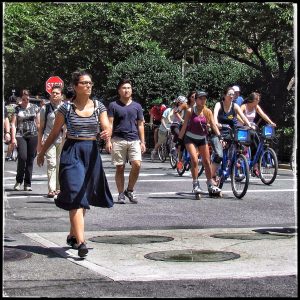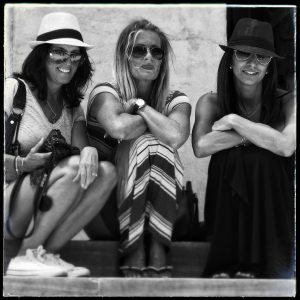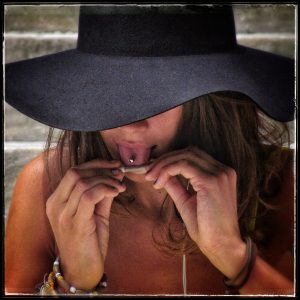This week in my bit of art writing I’m going to take a look at a little something that I forgot existed until I pulled it out of a drawer of drawings when I was looking for something else. It’s an odd drawing in that I haven’t done many in this size and shape. Three of them as a matter of fact because I found two more along with this one. Only one of the three had a date written on it but I’m pretty sure all three are from about the same time. That would be December of 2005.
The paper the drawing is drawn on is three inches wide by seventeen inches tall. That’s not your average piece of paper out there in the larger world but it is to me. I like to draw on eleven by seventeen inch bristol board but the pads of bristol that I buy are fourteen by seventeen inches. So I cut three inches off the side of my paper. Before I learned it was fun to make art cards, little baseball card sized drawings, and cut those strips of bristol down into a bunch of two and a half by three and a half inch pieces I used to have a bunch of long strips of paper hanging around the place. I never did much with them besides use them for scrap paper. A three by seventeen inch pieces of paper doesn’t have many uses.
Yet it seems for a couple of days back in December of 2005 I decided to draw on a few of those long and narrow sheets of paper. It looks like I was drawing with a Rapidograph technical pen. I can tell by the blackness of the ink (it’s India ink) and by the lack of line weight. Technical pens are pens that you fill with ink and they make a rigid single weight dark line. They come in different sizes and this looks like one of the larger sizes. I don’t even have this pen anymore. It was probably fifteen years old back in 2005 and it finally wore out on me some time after then. I replaced it but it’s replacement wore out in a couple of years. They don’t make them like they used to. That’t why I haven’t bothered trying to get a new one. Expensive and crappy is not a good combination.
These are spontaneous ink drawings. That means there was no planning involved. No sketching in pencil first. Just putting pen to paper, moving it around, and seeing what comes out. I’ll start at the top because I’m pretty sure that’s where I started drawing. It almost looks like I drew in in squares. At least at first. That must have been my way to get into such an unusual shaped piece of paper. The first square consists of a slim woman in a see through skirt, a cyclops, an odd swirl haired and one eyed profile, a smiling and helmeted man, what appears to be a dwarf, plus a bunch of shapes. That’s a weird collection of things. No one of them in particular stands out to me but together they make a fine interlocking square of drawings. An okay start.
In the second square of drawings we get a strange-faced portrait, a wide woman with her limbs coming off, a small three quarters view of a face, and some more shapes. Thought I kind of like the strange-faced portrait it’s the tiny three quarters view face that catches my eye most. I like the round eye with the line that comes of it to form the line of the hair. The line that encircles the top of the eye to make the brow and bridge of the nose is good too. I’d have no idea how to turn it into t larger drawing though. That happens a lot. Something that works at one scale won’t work at another. The nice balance of black and white line and shape that I find appealing at this scale will probably be hard to duplicate at a larger size.
With the third square we start to see the drawings blend a little more with the ones above and below. We get a man with a weird thing over his eye, two small busts, and what looks like a figure drawing of a mouse woman. The tops and bottoms of this set of drawings aren’t as square as the previous ones soon the squares will disappear all together. Meanwhile I like that mouse woman. Whiskers and mouse ears. What’s not to like? The man’s shoulders with eyes on them are reminiscent of a jacket I painted for myself.
The fourth square starts to really stretch out into a rectangle. We get a small bust, a large profile shot, and a small figure with a hat. The profile overlaps with the woman in the geometric fruit hat thus ending the theme of squares. I was getting more comfortable with the length of the paper and stopped breaking it down into smaller pieces in my mind.
Next to the fruit hat it looks like we have three people in a boat. I like them. Once again a nice small drawing that it would be hard to make into something larger. I like how there are waves under the boat with arches under that. It reminds me a little of Roman aqueducts. I find that neat. I’m not sure what that is under the aqueduct but it leads into what looks a little like a dog’s head.
Then we’re done with squares and rectangles. The bottom third of the drawing interlocks and we lose the geometry of smaller rectangles in the larger paper rectangle. Among the interlocking shapes are various forms and figures but the woman in the bottom left seems to dominate them all. We see her full figure and she’s bending an ankle, knee, hip, and elbow to turn and look at us. She’s in the middle of a gesture. She’s got a fancy hat too. I also like the face in profile that’s right next to her feet. It looks like a fancy dowager giving us a look of disapproval as her friend in front of her doesn’t even notice our presence. There might even be an exclamation point over the dowager’s head. Neat.
So there is a look at a bunch of little drawings that never went on to become anything else. They never gained a larger purpose or added up to anything but what they were. Some cool little drawings on an odd size piece of paper.





